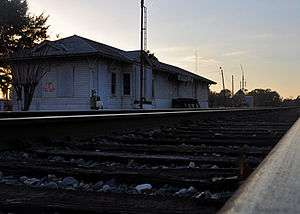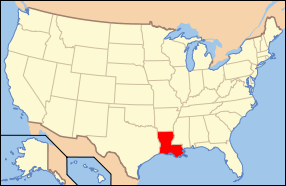Zwolle, Louisiana
| Zwolle, Louisiana | |
| Town | |
 Old Zwolle Train Station on Main Street | |
| Country | United States |
|---|---|
| State | Louisiana |
| Parish | Sabine |
| Elevation | 203 ft (61.9 m) |
| Coordinates | 31°38′06″N 93°38′33″W / 31.63500°N 93.64250°WCoordinates: 31°38′06″N 93°38′33″W / 31.63500°N 93.64250°W |
| Area | 3.7 sq mi (9.6 km2) |
| - land | 3.2 sq mi (8 km2) |
| - water | 0.4 sq mi (1 km2), 10.81% |
| Population | 1,783 (2000) |
| Density | 552.6/sq mi (213.4/km2) |
| Mayor | G.J. "Pie" Martinez |
| Timezone | CST (UTC-6) |
| - summer (DST) | CDT (UTC-5) |
| Area code | 318 |
|
Location of Zwolle in Louisiana | |
 Location of Louisiana in the United States | |
Zwolle (Za-wall-ee)[1] is a small town in Sabine Parish, Louisiana, United States. The population was 1,783 at the 2000 census.
History
The first inhabitants of the bowl-shaped area of land upon which the town of Zwolle is situated were the Mound Builders. Lured here for protection from storms, the "bowl" offered them protection. Prehistoric people built the dome-shaped mounds that line the banks of Bayou Scie and Bayou San Miguel, which form a hollow circle around the townsite. As Mound Builders, they were ancestors of North American Indians who owned and inhabited the territory when the Europeans arrived.
Later, the area was colonized by Spain, which sent the earliest non-Indians to the territory. A Spanish mission church was built at Bayou Scie. Spanish soldiers and Native people intermarried over many generations, and colonial Spanish (not Mexican Spanish) was still spoken in the area until the 1970s.
The first English-speaking settlers arrived in Sabine Parish in 1824, via Natchitoches. These pioneers came chiefly from Mississippi, Alabama, Georgia, and the Carolinas. In 1871, many more of these settlers moved in and acquired land under the homestead act. [2]
Arthur Stilwell built the Kansas City Southern Railroad from Kansas City to Port Arthur, Texas. He had reached Van Buren, Arkansas in 1893 when he ran out of funds. Stilwell went to Zwolle, the Netherlands and met with a rich coffee merchant Jan De Goeijen. De Goeijen was impressed with St. Joseph Catholic Church, a product of the early Spanish missionaries which stood overlooking the town. De Goeijen sold a $3,000,000 stock issue for Stilwell's railroad and he was permitted to name the place after his hometown and birthplace of Zwolle, a riverside city of currently over 120,000 population in the Netherlands.[3] The charter for the town of Zwolle was granted June 12, 1898.
Geography
Zwolle is located at 31°38′6″N 93°38′33″W / 31.63500°N 93.64250°W (31.635134, -93.642560).[4] According to the United States Census Bureau, the town has a total area of 3.7 square miles (9.5 km²), of which, 3.2 square miles (8.4 km²) of it is land and 0.4 square miles (1.1 km²) of it (11.99%) is water.
Demographics
| Historical population | |||
|---|---|---|---|
| Census | Pop. | %± | |
| 1900 | 276 | — | |
| 1910 | 973 | 252.5% | |
| 1920 | 909 | −6.6% | |
| 1930 | 1,264 | 39.1% | |
| 1940 | 1,500 | 18.7% | |
| 1950 | 1,555 | 3.7% | |
| 1960 | 1,326 | −14.7% | |
| 1970 | 2,169 | 63.6% | |
| 1980 | 2,602 | 20.0% | |
| 1990 | 1,779 | −31.6% | |
| 2000 | 1,783 | 0.2% | |
| 2010 | 1,759 | −1.3% | |
| Est. 2015 | 1,972 | [5] | 12.1% |
As of the census[7] of 2000, there were 1,783 people, 630 households, and 437 families residing in the town. The population density was 552.6 people per square mile (213.1/km²). There were 725 housing units at an average density of 224.7 per square mile (86.7/km²). The racial makeup of the town was 6.37% White, 47.17% African American, 16.38% Native American, 1.07% from other races, and 2.02% from two or more races. Hispanic or Latino of any race were 33.17% of the population.
There were 630 households out of which 39.4% had children under the age of 18 living with them, 36.8% were married couples living together, 27.9% had a female householder with no husband present, and 30.5% were non-families. 27.5% of all households were made up of individuals and 12.9% had someone living alone who was 65 years of age or older. The average household size was 2.73 and the average family size was 3.36.
In the town the population was spread out with 35.5% under the age of 18, 9.0% from 18 to 24, 23.8% from 25 to 44, 17.0% from 45 to 64, and 14.6% who were 65 years of age or older. The median age was 30 years. For every 100 females there were 82.3 males. For every 100 females age 18 and over, there were 75.3 males.
The median income for a household in the town was $15,843, and the median income for a family was $17,326. Males had a median income of $25,625 versus $14,922 for females. The per capita income for the town was $9,042. About 37.7% of families and 40.5% of the population were below the poverty line, including 52.8% of those under age 18 and 35.9% of those age 65 or over.
Education
Zwolle High School, Intermediate, and Zwolle Elementary School are combined into one building. The school has 1,500 students.
Culture
Zwolle Tamale Fiesta
The Zwolle Tamale Fiesta is the town's signature festival. Originating in the late 1970s, the fiesta celebrates the Hispanic heritage rooted in the town's origins. The fiesta takes its name from the tamale and alludes to the town's local notoriety for what is arguably a spicier version of the Mississippi Delta-style boiled tamale, which is believed to have been made in the area since the early 1700s.[8]
The festival was traditionally held on the campus of Zwolle High School on the 2nd weekend of October, kicking off on Thursday night and concluding on Sunday. The practice continued until the early 2000s when the town completed a festival grounds area. The Fiesta relocated to the grounds and scaled back to conclude on Saturday night. Attractions include cultural exhibitions, a parade, a ball, a small-scale carnival and most recently, a mud bog competition.
Loggers and Forestry Festival
Founded in 1995, The Loggers and Forestry festival pays tribute to workers in the community's horticulture industry - the cornerstone of the local economy. Each year, while a queen is decided via a pageant, the oldest-living logger residing in the town is named king.
The Loggers and Forestry festival is held on the town's festival grounds and bears many similarities to the Tamale Fiesta, to include several of its signature events. The festival is typically held in early May. It is the town's second largest local event.
Notable people
- Former Lieutenant Governor William J. "Bill" Dodd (1909-1991) graduated from Zwolle High School.
- D. L. Dykes, Jr., pastor of the First United Methodist Church in Shreveport, began his ministerial career at the denominational church in Zwolle.
- Michael Cutright of the 1989 Denver Nuggets, played basketball at Zwolle High School and still resides in the area.[9]
- Michael McClanahan, 2014/2015 President of the Baton Rouge Chapter of the NAACP is married to Patricia McClanahan. [10]
References
- ↑ The Pelican Guide to Louisiana. Pelican Publishing. p. 39. ISBN 978-1-4556-1023-5.
- ↑ www.toledo-bend.com "A Look At Zwolle's Early History" Archived September 26, 2007, at the Wayback Machine.
- ↑ www.zwollela.net "The Story of Zwolle Louisiana" Archived February 19, 2008, at the Wayback Machine.
- ↑ "US Gazetteer files: 2010, 2000, and 1990". United States Census Bureau. 2011-02-12. Retrieved 2011-04-23.
- ↑ "Annual Estimates of the Resident Population for Incorporated Places: April 1, 2010 to July 1, 2015". Retrieved July 2, 2016.
- ↑ "Census of Population and Housing". Census.gov. Archived from the original on May 11, 2015. Retrieved June 4, 2015.
- ↑ "American FactFinder". United States Census Bureau. Archived from the original on September 11, 2013. Retrieved 2008-01-31.
- ↑ "Archived copy". Archived from the original on April 13, 2010. Retrieved May 3, 2010.
- ↑ http://www.thedraftreview.com/index.php?option=com_content&view=article&id=2429:michael-cutright&catid=27:1989-nba-draft
- ↑ http://www.naacpbr.org/branch-leadership.html
